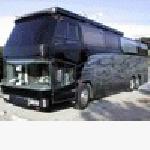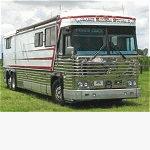| Author | Message | ||
| John Elnitski (Ski43)
Registered Member Username: Ski43 Post Number: 10 Registered: 1-2007 Posted From: 71.58.59.233 Rating: N/A |
I am hooking up my house batteries and conveter to a 12 v distrubution panel and have some questions. 1. should I have a switch to turn off power from house batteries to the panel when using the converter, should I also have a switch between the converter and the panel 2. what size wire should I use from house batteries and panel and from converter to panel 3. should I take the ground to the panel from the bus body or go to the negative of the house batteries. thanks for any help | ||
| Bob Wies (Ncbob)
Registered Member Username: Ncbob Post Number: 264 Registered: 2-2006 Posted From: 70.220.167.78 Rating: |
John, as is so often the case when a Member asks for advice it's what is missing that is mostly the key to our being able to help you...and I hope I'm not beating a too redundant drum here. Model and year of your bus will help immensely. Many of our guys have already done what you're about to tackle and have realized that if they could do it over they might change a couple of items....so Please try to give us as clear a picture of your bus and where your lighting batteries and inverter are located so we might be able to give you a clearer blueprint, even maybe some pix, to do what it is you need to do. Not all buses are alike. Many books and articles have been written on many of these subjects so a search of the archives will always stand you in good stead. HTH NCbob | ||
| John Elnitski (Ski43)
Registered Member Username: Ski43 Post Number: 11 Registered: 1-2007 Posted From: 71.58.59.233 Rating: N/A |
It is a MCI 9, inverter and converter under front couch with good ventilation. House batteries right below inverter in ac condenser bay(road ac removed). Distrubution panel in cabinet in Kitchen at mid point on bus (distance 10 feet to converter, 20 to house batteries.) | ||
| Sean Welsh (Sean)
Registered Member Username: Sean Post Number: 730 Registered: 1-2003 Posted From: 67.142.130.28  Rating: |
We need to know the make and model of converter and inverter, the voltage, size (in amp-hours), and type (AGM, Gel, or flooded) of the battery bank, and the total expected load on the system in order to answer any of your questions except #3, where the answer is to wire directly from the load center to the battery negative, and also tie the battery negative to the frame at the closest possible point. HTH, -Sean http://OurOdyssey.BlogSpot.com | ||
| John Elnitski (Ski43)
Registered Member Username: Ski43 Post Number: 12 Registered: 1-2007 Posted From: 71.58.59.233 Rating: N/A |
I have a RV Dimensions Unlimited inverter. Model number WIN-12X20B3RT. Specifications: Millennium Series Standby Power Systems (SPS) Output Voltage (VAC) 120 RMS ±5% Output Frequency: 60 Hz ± 0.05% Output Waveform: Quasi-sine wave, with waveform stabilizer Input Voltage: (VDC) 11 to 14 Operating Temperature: -20° to 40° C (0° to 104° F) Efficiency: Up to 93% Other Design Features: Thermally controlled cooling fan. Enclosed AC and DC cable connections with strain relief. Built-in battery charger and transfer relay Remote Control Panel: LCD Display - Blue background, 16 white characters by two lines. User-friendly messages. Dimensions W x H x D: 5.75 x 3.75 x 1.25 Unit Protection: Automatic electronic short circuit/overload protection Automatic high temperature shutdown Automatic low battery shutdown at 10.5 VDC (with in-rush delay) Detailed Specs: Output Power (Watts Cont.) 2,000 Output Current (Amps AC) Up to 16.5 Peak Output (Amps AC) 70 Output Rating: (hp) ½ Input Current (Amps DC) Up to 200 Weight (lbs.) 44 Dimensions LxWxH (Inches) 15¾ x 11½ x 7¾ BATTERY CHARGER (Built-in) 3 step charger with automatic conditioning; Temperature compensated output voltage; selectable between wet and sealed lead acid batteries; selectable between small and large battery banks Output Current (Amps DC) 100 Input Current (Amps AC) Up to 21 TRANSFER RELAY (Built-in) Fail-safe shore power Transfer Relay Current Rating (Amps AC) 30 Transfer Time (milliseconds) Less than 16 typical Usage: Any 120 VAC, 60 Hz single-phase products within the inverter's power rating that does not require a pure sine waveform. I am using 6 - 6 volt golf cart batteries - wet cell Do I need a conveter when I run off of AC or does the inverter supply 12 vdc when charging to power my 12 vdc stuff, like heat, water pump, lights. | ||
| Sean Welsh (Sean)
Registered Member Username: Sean Post Number: 731 Registered: 1-2003 Posted From: 72.171.0.147  Rating: N/A |
John, It looks like your inverter already has a built-in charger. So, no, you do not necessarily need a converter. In fact, I would say that most of us with charging inverters do not use converters. A converter will, however, do two things for you: 1. It will provide a more regulated DC voltage to your DC appliances when you are plugged in. The inverter's built-in charger will put out close to 15 volts when in the "bulk" charge phase, and, while most 12-volt accessories will run fine on this, you might find the lights to be a little bright, and it might shorten the life of the bulbs by a few percent. 2. It will handle all the DC loads, allowing all 100 amps of the charger's output to go into the batteries, for a slightly faster charge. But most coaches have only a few amps of DC running at any time. Also, you are still limited by the size of your shore power connection and/or generator output. So the choice is yours. Just remember that, in order for the converter to work at all, the batteries must be disconnected from the DC loads. Most converters have internal relays to accomplish this. -Sean http://OurOdyssey.BlogSpot.com | ||
| Sean Welsh (Sean)
Registered Member Username: Sean Post Number: 732 Registered: 1-2003 Posted From: 72.171.0.143  Rating: N/A |
John, Forgot, in my last response, to answer the other part of your question: For an eight-foot cable run (my estimate based on you saying the inverter is in the coach somewhere above the batteries in the condenser bay), 00 ("two ought" or 2/0) is the minimum gauge you want to run. That will cover your 200-amp max load, and will give you a 2.13% voltage drop, which is acceptable. Bigger cable is always better, because it will run cooler, waste less energy (lower voltage drop), and allow you to add battery, charger, or inverter capacity later. For the minimal difference in cost, I would run 0000 (four ought). FWIW. -Sean http://OurOdyssey.BlogSpot.com | ||
| John Elnitski (Ski43)
Registered Member Username: Ski43 Post Number: 13 Registered: 1-2007 Posted From: 71.58.59.233 Rating: N/A |
The batteries are about 20 ft from the distr. panel, while the inverter is about 10 feet due to how I would have to run cable, what size cable should I run to the panel, should I run direct from batteries to panel or can I run to the inverter and at the same attachment point on the inverter run cables to the panel and is double ought 00 different than 2/0, I have 2 gauge welding wire. | ||
| Tom Caffrey (Pvcces)
Registered Member Username: Pvcces Post Number: 1217 Registered: 5-2001 Posted From: 65.74.72.93 Rating: N/A |
John, your wire is only half the capacity that Sean says you need and not much over 1/4 the capacity that he recommended. For what it's worth. Tom Caffrey PD4106-2576 Suncatcher Ketchikan, Alaska | ||
| George M. Todd (George_mc6)
Registered Member Username: George_mc6 Post Number: 497 Registered: 8-2006 Posted From: 207.231.75.253 Rating: N/A |
John, Wire gauge grows LARGER as the numbers get SMALLER, until you get to 0, then they go up, as in 00, 000, 0000, then it goes to MCM, with 250 MCM being the next size above four ought. So, if you have #2AWG, the next larger size is #1, then 0, then 00, etc. Double 00, and 2/0 are the same, it will be stamped 2/0 on your wire. Sean has given you the absolute correct advice, and Tom and I will echo it! You should keep the runs as short as possible, and if the inverter is between the batts and the panel, it would be fine to make a connection there. NOW, have you gotten something by all of us? Namely an MC9 came 24 Volt! Do you have OTR house battery charging? If so, all the advice above will have to change. If you don't have OTR charging, I personally don't feel you will be happy about lack of capacity, and arriving half charged. Please post back with some more info, and we'll try and sort this out! Regards, George | ||
| John Elnitski (Ski43)
Registered Member Username: Ski43 Post Number: 14 Registered: 1-2007 Posted From: 71.58.59.233 Rating: N/A |
I do not have otr charging yet, thanks for bringing it up. Right now I do not travel much, but when I do, I have a temporary system set up and run the gen set to run AC units and inverter charges batts, so it is not a problem, but would love to know how to implement otr charging. I have a 1981 MC 9. | ||
| George M. Todd (George_mc6)
Registered Member Username: George_mc6 Post Number: 498 Registered: 8-2006 Posted From: 207.231.75.253 Rating: N/A |
John, For a quick answer, before I have to leave for work, OTR charging can be done with either a large continuous duty solenoid, or a diode separator. The solenoid takes control wiring, which the separator doesn't. The problem is a 24V chassis with 12V house wiring, 6-6V house batteries, and a 12V inverter. If you had either 4 or eight 6V batts, it becomes easier, and a 24V inverter takes HALF the cable sizing of a 12V! Then you install a Vanner equalizer, and it works well. More later, and please put your bus model in your profile, then we won't have to keeep asking! Good luck, George | ||
| Jack Conrad (Jackconrad)
Registered Member Username: Jackconrad Post Number: 787 Registered: 12-2000 Posted From: 76.3.173.51  Rating: N/A |
If your inverter and house battery bank are 12 volt, you can add a "one wire" 12 volt alternator to your engine. On our MC-8, we made a bracket for the alternator where the OEM air conditioner compressor had been and run the belt off a crankshaft groove that was formerly used the the air conditioning compressor. Jack | ||
| John Elnitski (Ski43)
Registered Member Username: Ski43 Post Number: 15 Registered: 1-2007 Posted From: 71.58.59.233 Rating: N/A |
My battery bank is up front and thats at least forty feet of wire, any other ways to do it. | ||
| FAST FRED (Fast_fred)
Registered Member Username: Fast_fred Post Number: 411 Registered: 10-2006 Posted From: 208.100.193.153 Rating: N/A |
My battery bank is up front and thats at least forty feet of wire, any other ways to do it. Depends , on many GM the huge blowers for the HVAC setup are in a forward compartment. Since the stock system is usually discarded the wires which are rated to run 2x80A blowers are aviliable for 160A + of battery charging. A huge amount for most battery banks. See what you can recycle . FF | ||
| John Elnitski (Ski43)
Registered Member Username: Ski43 Post Number: 16 Registered: 1-2007 Posted From: 71.58.59.233 Rating: N/A |
I have a 1981 mc 9, I did take out the ac, does anyone know of any wires I can use from the back to the front. |